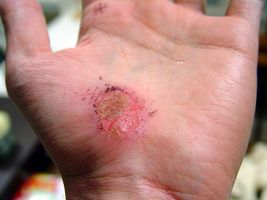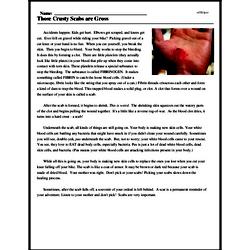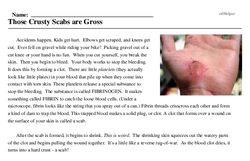Those Crusty Scabs are Gross
Accidents happen. Kids get hurt. Elbows get scraped, and knees get cut. Ever fell on gravel while riding your bike? Picking gravel out of a cut knee or your hand is no fun. When you cut yourself, you break the skin. Then you begin to bleed. Your body works to stop the bleeding. It does this by forming a clot. There are little platelets (they actually look like little plates) in your blood that pile up when they come into contact with torn skin. These platelets release a special substance to stop the bleeding. The substance is called FIBRINOGEN. It makes something called FIBRIN to catch the loose blood cells. (Under a microscope, fibrin looks like the string that you spray out of a can.) Fibrin threads crisscross each other and form a kind of dam to trap the blood. This trapped blood makes a solid plug, or clot. A clot that forms over a wound on the surface of your skin is called a scab.
After the scab is formed, it begins to shrink. This is weird. The shrinking skin squeezes out the watery parts of the clot and begins pulling the wound together. It's a little like a reverse tug-of-war. As the blood clot dries, it turns into a hard crust - a scab!
Underneath the scab, all kinds of things are still going on. Your body is making new skin cells. Your white blood cells are battling any bacteria that might have snuck in if you didn't clean your wound carefully. Sometimes you will see, double-yuk, pus underneath the scab. But, not to worry; your white blood cells came to your rescue. You see, they love to EAT dead body cells, especially bacteria. Pus is just a lot of dead white blood cells, dead skin cells, and bacteria. (Pus means your white blood cells are attacking infections present in your body.)




